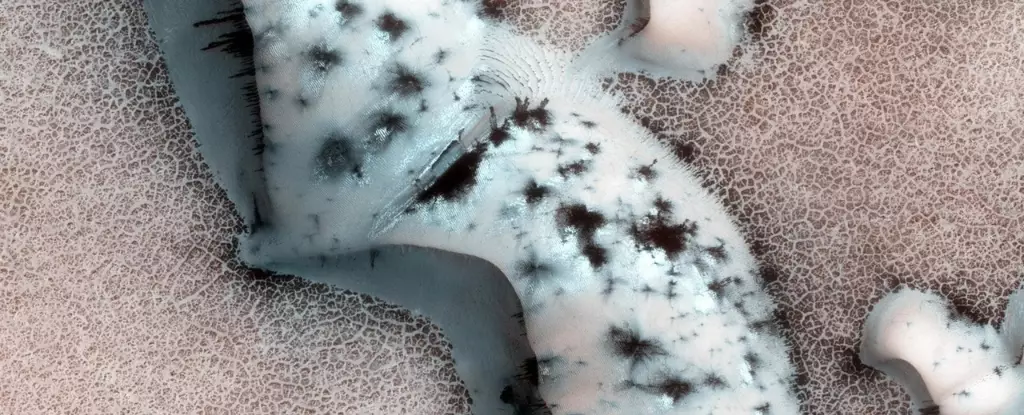Mars is often dubbed the “Red Planet,” renowned for its desolate landscape and frigid climate. Yet beneath this cold exterior lies a world of astonishing geological phenomena that continue to captivate scientists and space enthusiasts alike. With an atmosphere so thin that life as we know it cannot survive, Mars possesses a beauty that is strikingly unique—one that stands in stark contrast to Earth’s lush ecosystems.
Mars is enveloped by an atmosphere composed predominantly of carbon dioxide (about 95%). This thin layer is crucial for understanding the planet’s seasonal cycles. During the Martian winter, the temperatures drop significantly, causing carbon dioxide to freeze into solid ice, forming extensive polar caps. This frozen layer sits silently on the Martian surface until the warming spring months coax it back into its gaseous form, revealing a dramatic interplay between solid and vapor phases. The subtle transition from winter to spring on Mars is not just a temperature change; it sets the stage for astonishing geological events that can transform the surface landscape overnight.
The properties of the Martian atmosphere make it immensely different from Earth’s, and understanding this distinction is integral to grasping the unique phenomena associated with Martian CO2 geysers.
The Geysers of Mars: Nature’s Spectacle
The Martian spring initiates a process that is both mesmerizing and scientifically rich: the sublimation of frozen carbon dioxide. As the ground begins to warm beneath the translucent icy layer, pressure builds up underneath through gas accumulation. Eventually, this high-pressure gas finds weak points in the CO2 ice, leading to spectacular eruptions. These eruptions are not merely small-scale; some are powerful enough to produce dark spots on the surface that can expand up to 1 kilometer across.
Captured by NASA’s HiRISE camera on the Mars Reconnaissance Orbiter, these geysers depict an otherworldly tableau, as they burst forth at speeds reaching 160 km/h. The resultant dark stains often resemble fascinating and intricate patterns reminiscent of spider webs, aptly termed “araneiform terrain.” These features are not only visually captivating but also provide significant insight into the geological processes that shape the Martian surface.
The web-like formations observed on Mars present an intriguing geological puzzle. Named for their resemblance to spider webs, these structures are produced through multiple cycles of gas buildup and eruption. Scientists, including those from NASA, have endeavored to recreate these phenomena in controlled lab settings to unlock the mysteries behind their formation. This research traces back to the Keiffer model, which posits that the ice slab accumulating over time becomes a pressure vessel that erupts in a spectacular display when the tension reaches its threshold.
Not only have these scientists brought light to the active geological forces at play on Mars, but they have also unveiled how such processes differ fundamentally from any observable phenomena on Earth. This revelation has profound implications for how we comprehend planetary geology and the conditions that give rise to diverse surface features.
Aesthetic Appreciation of Martian Landscapes
It is fascinating to consider how human perception shapes our understanding of beauty in the cosmos. While poets and artists have long lauded the romantic allure of Earth, Mars presents a different aesthetic—one inspired by stark contrasts and unusual geological formations. The CO2 geysers and their resulting patterns evoke a sense of wonder, not in spite of their coldness, but because of it.
The Martian landscape, characterized by its barren yet striking geological features, encourages a more profound appreciation for the diversity of celestial bodies. Where Earth boasts verdant landscapes and rolling hills, Mars reveals an ancient world of untamed beauty, sculpted by physics rather than flora and fauna.
Mars, while often perceived as a cold, lifeless planet, encapsulates a beauty that invites us to rethink our definitions of natural splendor. Its unique geological phenomena, particularly the CO2 geysers and araneiform terrain, not only challenge our preconceived notions of planetary landscapes but also urge us to appreciate the beauty that lies even in desolation. As we continue to explore Mars and unveil its secrets, we deepen our understanding of the complexities and marvels of our solar system, ultimately reminding us that beauty exists in multifaceted forms across the cosmos.


Leave a Reply